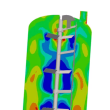Loading...
Project
Universität zu Köln (UzK)
Universität zu Köln Project Description
The Chair for Numerical Mathematics and Scientific Computing (Prof. Dr. Axel Klawonn) has many years of expertise in the development of parallel scalable, iterative solvers for partial differential equations. Here, a focus lies on the development and parallel implementation of new, robust and fast domain decomposition methods and multilevel methods. The parallel implementations in the packages Trilinos [88] and PETSc [4] are regularly developed and tested and scaled on supercomputers from the TOP20 class [92] [46, 45, 36, 40, 35]. Previous applications were in the areas of continuum mechanics [44, 46, 48] and the life sciences - including fluid simulations or coupled applications such as fluid-structure interaction [32, 33]. The FROSch package [36], which is to be further developed in this project, was used very successfully to solve the latter examples. The monolithic two-level approaches presented in [32, 33] for solving Stokes and Navier-Stokes problems are to be extended to a higher parallel scalable three-level procedure and implemented in this project. Three-level Schwarz methods for diffusion and elasticity problems are already present in FROSch; see [40, 37, 39]. On the other hand, the monolithic coarse-grid spaces from [32, 33] should be integrated into the non-linear two-level Schwarz methods from [38, 34] to accelerate the non-linear convergence and the resulting methods should be implemented in parallel. There is already a large amount of experience in the parallel implementation of similar non-linear domain decomposition methods [45, 47] at the chair.
The Chair for Numerical Mathematics and Scientific Computing (Prof. Dr. Axel Klawonn) was involved in the EXASTEEL project from 2012-2019. During the course of the EXASTEEL project, which was part of the DFG-funded priority program 1648 SPPEXA - Software for Exascale Computing, expertise could also be built up with regard to Exascale Computing. In particular, homogenization methods, but also non-linear domain decomposition methods were considered; see [44, 46, 48].





